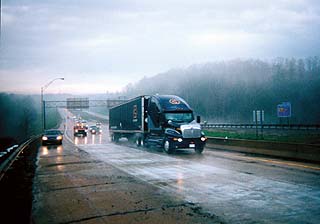|
Subscribe / Renew |
|
|
Contact Us |
|
| ► Subscribe to our Free Weekly Newsletter | |
| home | Welcome, sign in or click here to subscribe. | login |
Construction
| |
 |
June 18, 2004
Concrete, technology are a powerful mix
Master Builders Inc.

Photo courtesy of Rosenthal CAC
Self-consolidating concrete in Cincinnati’s Rosenthal Center for Contemporary Arts increased worker productivity. |
Concrete construction today is more challenging than ever. Take, for example, a freeway or airport pavement that is in need of repair yet must carry traffic. The challenge is to make the repair as quickly as possible to minimize traffic congestion and inconvenience to motorists.
Structures today, such as Seattle's Two Union Square, are bigger, taller and more complicated to build. The challenge is to facilitate easier and faster concrete construction while meeting the engineering and architectural demands for strength, durability and aesthetics.
Concrete producers, themselves, face challenges in securing raw materials.
Innovative chemical admixtures have been recently developed that significantly change the characteristics of concrete and impart many desirable properties that allow concrete to be used in challenging applications never before possible.
Reducing traffic congestion
To help transportation agencies meet the demands for fast-track pavement repairs, one admixture supplier partnered with concrete producers and the California Department of Transportation to develop an innovative high-early strength concrete solution.
While high-early strength concrete is not new, repairing concrete pavements is now faster than ever with a system of innovative high-range water-reducing, hydration controlling, and set- and strength-accelerating admixtures. The user-friendly mix allows traffic to travel across the surface in four hours or less after placement. It also can be modified to meet specified strength criteria by adjusting the mixture proportions.
The West Virginia Turnpike is an example of how this technology can benefit the traveling public. Several stretches of the I-77/I-64 West Virginia turnpike needed to be replaced due to deteriorating asphalt lanes. The turnpike commission was interested in a fast-track replacement to minimize inconvenience to motorists.
A local ready-mix concrete producer was asked to develop a mixture that would achieve the required compressive strength, even in cool springtime ambient temperatures.
The first phase of the project began around 7 p.m., with removal of the deteriorated pavement sections and preparation of the subgrade for fresh concrete. The unique high-early strength concrete was then delivered, placed and cured by 1:30 a.m. The target of 2,000 psi compressive strength was easily achieved and the lane reopened in time for early morning rush hour.
Enhancing productivity
Today's admixture technology allows concrete to be placed without vibration for consolidation, thereby enhancing productivity.
Chemical admixtures have been used since the 1930s to help make concrete flow better so it's easier to place. Innovative high-range, water-reducing and viscosity-modifying admixtures can take today's concrete to a new level of workability.
Using these chemical admixtures, self-consolidating concrete (SCC), also called self-compacting concrete, can be produced with high fluidity and non-segregating characteristics that allow it to flow into place, fill formwork and encapsulate reinforcement without any mechanical consolidation such as vibration.
SCC benefits for the concrete producer and contractor include:
- Controlled workability and flow
- Mixture proportioning flexibility
- Improved surface appearance (less honeycombing, bugholes and air pockets)
- Less wear and tear on equipment
- Less noise on job sites
- Increased safety
- Faster completion of projects
- Less patching and reworking of jobs/pieces
- Lower installed cost
Engineers are pleased with other benefits of SCC, such as improved consolidation in areas containing reinforcement, excellent engineering properties and overall structural integrity.

Photo courtesy of Master Builders Inc.
High-early strength concrete used in resurfacing the West Virginia Turnpike allowed it to open less than four hours after placement. |
The Rosenthal Center for Contemporary Arts in Cincinnati recently posed two big challenges during construction. One component in the design of this building was a concrete roll-up section that resembled a 96-foot skateboard ramp and connected the wall to the floor. The form for this curved roll-up provided little access for internal vibration. In addition, formwork for the structural diamond-shaped columns consisted of square column forms with plywood inserts to create the diamond shape. The form detail resulted in “dead areas” on two sides that restricted access for proper vibration of the concrete.
In order to ensure proper consolidation and to minimize surface blemishes, self-consolidating concrete using a blend of aggregates and a combination of innovative high-range water-reducing and viscosity-modifying admixtures, was selected for both the roll-up section and the diamond-shaped columns. The result was productivity increases approaching 350 percent and a finished project that looks fantastic.
Increasing workability
Because of quality material availability issues, a concrete producer is sometimes forced to use sand that is angular or “gap-graded” (deficient amounts retained on a given sieve size). These sands can make a mix that is harsh and difficult to place, pump and finish — affecting concrete workability. In addition, gap-graded sand has a tendency to cause concrete to bleed excessively, creating problems in the timing of the finishing operation and potentially compromising surface durability.
Modern viscosity-modifying admixtures (VMA) can be added to concrete containing these types of sand to take the edge off their harshness. Concrete containing a VMA will exhibit “more body,” imparting a remarkable change in the flowing characteristics, making them much more easy to place, pump and finish.
The use of specific VMA products will also control bleeding, which helps the finishing operation. A VMA can also be used in concrete mixtures made with high-quality aggregates to achieve a similar effect.
Concrete producers facing a shortage of high-quality aggregates are using a VMA in their mixes to deliver quality concrete that consistently achieves the desired workability properties for the contractor.
The novel admixtures available today are more sophisticated than those produced just a few years ago and provide many advantages and solutions to challenging concrete production and placement. Contractors and end-users benefit from concrete that is easy to install, obtains the necessary properties to remain durable for a long time, and is cost-effective in place.
Mark A. Bury is a senior product manager with Master Builders Inc. He has been in the concrete industry for 23 years and has published numerous papers in industry journals. He is also a fellow of the American Concrete Institute and a member of the American Society for Testing and Materials.
Other Stories:
- Polyester concrete — a quick fix for roadways
- Shedding a new light on the heavy stuff
- Concrete struts its stuff in Washington, D.C.


